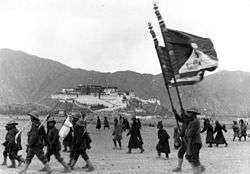Flag of Tibet

The Tibetan flag, also known as the "snow lion flag" (gangs seng dar cha),[1] was the national flag of Tibet, adopted by the 13th Dalai Lama in 1916.[2] Banned by the Chinese authorities since 1959, today the flag is used by the Tibetan Government in Exile, based in Dharamsala, India. [3]
Design and early use

In February 1913, shortly after the fall of the Qing dynasty, the 13th Dalai Lama, Tibet's political and spiritual leader, declared independence from China and began modernizing the Tibetan army.[4] In 1916, the new national flag was adopted by the Dalai Lama and all army regiments were ordered to carry flag in its present form.[5]

In addition to being carried by Tibet’s army, the flag was displayed on public buildings of the Ganden Phodrang government. Historical footage shows the flag flying at foot of the Potala Palace, the site of the Dalai Lama’s government in Tibet.[6] The snow lion motif was also used on a flag seen by English diplomat, Sir Eric Teichman, flying above a Tibetan government building during the 1917-1918 Sino-Tibetan War: “Over the Kalon Lama’s residence...floats the banner of Tibet, a yellow flag bearing a device like a lion in green, with a white snow mountain and a sun and moon in the corner."[7]
Outside of Tibet, the flag was featured in publications by foreign governments, academic journals, and in politically and culturally significant works up until 1959.[8] Its first official international appearance was in a book published by the German Ministry of Defense's Naval Command, "Flaggenbuch," in 1926. [9] Later it was featured in an official British Crown publication in 1930, "Drawing of The Flags of All Nations." [10] It was also featured in National Geographic Magazine in their 1934 “Flags of the World” edition. The caption reads, "Tibet.- With its towering mountain of snow, before which stand two lions fighting for a flaming gem, the flag of Tibet is one of the most distinctive of the East."[11] Beginning in 1928, images of the Tibetan flag were also widely published by companies in Europe, North America, South America, the Middle East, and Oceania in national flag collections on various forms of trading cards.[12]
The flags first appearance at an international gathering was in March/April 1947 at the Asian Relations Conference in New Delhi. The Indian Council of World Affairs, an Indian think-tank established in 1943, had invited Tibetan delegates to the conference which hosted Asian states and anti-colonial movements[13] The leaders of each of the thirty-two delegations sat on a dais behind a plate with the name and flag of their country.[14] A tibetologist, A. Tom Grunfeld, asserts that flag was removed after representatives from the Republic of China protested conference organizers.[15] A Tibetan delegate who attended the conference claims that this did not occur and the only existing photos from the conference show the flag displayed along with other participating countries' flags.[16]
The flag continued to be used in the 1950s under the newly established People's Republic of China, although the flag's status was unclear. Many in the Communist Party of China felt that the usage of the flag indicated separatism, but the Tibetan local government at the time stressed that the flag was an army flag (the Tibetan army continued to exist parallel to People's Liberation Army infantries) and not a national flag. Phuntso Wangye claims that Mao Zedong discussed the flag in 1955 conversation with the 14th Dalai Lama. According to the story, Mao told the Dalai Lama that Zhang Jingwu, Zhang Guohua, and Fan Ming told him that Tibet had a "national flag". The Dalai Lama replied that Tibet had an army flag. Supposedly Mao replied that "you may keep your national flag". There is no official recognition of this conversation in Chinese documents, though.[17]
Even while it was used by the army, few Tibetans in Tibet knew about the 'snow lion' flag, and so when they wanted to protest against the government, they would use a flag that imitated the flag of Chushi Gangdruk instead.[18]
Pro-independence symbol

After the 1959 Tibetan Rebellion, the 14th Dalai Lama left his position as governor of Tibet, denounced the 17-point agreement with the PRC, and established the exile Central Tibetan Administration in India. As part of his project to inculcate pan-Tibetan nationalism (of all Tibetan people and not just those in his previous domain of the Tibet Autonomous Region), he standardized and adopted symbols as nationalist symbols, such as the Lhasa dialect of Tibetan, a Tibetan national anthem, and the flag.[19] According to the Central Tibetan Administration website, the symbolism of the flag includes the mountain representing Tibet, the snow lions of "a unified spiritual and secular life", three-coloured jewel of the Buddha, the Dharma and the Sangha.[20] The flag is popular known as the Snow Lion Flag due to the presence of the two snow lions.[21] The flag was adopted as a symbol of the Tibetan independence movement, and has become known as the "Free Tibet flag".[22][23] Through the diaspora's and international protesters' use of the flag, it became known and used in protest by the Tibetan public.[19] The flag is banned in mainland China.[22]
See also
References
- ↑ Goldstein, Melvyn C. (2009). A History of Modern Tibet: The Calm Before the Storm: 1951-1955. 2. University of California Press. p. 203.
- ↑ Tsarong, Dundul Namgyal (2000). In the Service of His Country: The Biography of Dasang Damdul Tsarong Commander General of Tibet. Snow Lion Publications. p. 51.
- ↑ Administration, Central Tibetan. "The Tibetan National Flag". Retrieved 25 August 2016.
- ↑ Sheel, R. N. Rahul. "The Institution of the Dalai Lama". The Tibet Journal, Vol. XIV No. 3. Autumn 1989, pp. 20.
- ↑ Tsarong, p. 51.
- ↑ Cruickshank, Dan (Director) (November 15, 2006). The Lost World of Tibet (Motion picture). Tibet: British Broadcasting Corporation (BBC), Cruickshank. Event occurs at 38:16.
- ↑ Teichman, Eric, Sir (1922). Travels of a consular officer in Eastern Tibet. London: Cambridge, Univ. Press.
- ↑ Flag, Tibetan. "Tibetan Flag in Reference Books". Retrieved 10 March 2016.
- ↑ Marineleitung, Germany (1926). Flaggenbuch. Berlin: Druck und Verlag der Reichsdruckerei.
- ↑ Admiralty, By Authority (1930). Drawings of the Flags of All Nations. London: His Majesty’s Stationary Office.
- ↑ Grosvenor, Gilbert; Showalter, William J. (September 1934). "Flags of the World". The National Geographic Magazine. Washington, D.C.: National Geographic Society. LXVI – No. 3.
- ↑ Gulotta, Nick; Yangzom, Dicky. "Tibet on the Cards of History: Revisiting the Tibetan National Flag". Retrieved 23 March 2015.
- ↑ Claude Arpi, Tibet, le pays sacrifié, Bouquineo, 2011, p. 225: "À la fin de 1946, la rumeur circula à Lhassa qu’une délégation du gouvernement tibétain allait être invitée en Inde pour participer à une conférence panasiatique. Le représentant britannique à Lhassa, Hugh Richardson, transmit l’invitation officielle du Conseil indien pour les Affaires mondiales au gouvernement [tibétain]." (The British representative in Lhasa, Hugh Richardson, conveyed the Indian Council of World Affairs' official invitation to the [Tibetan] government).
- ↑ Arpi, Claude. "Fifty Years Ago: The Asian Relations Conference". Phayul. Phayul.com. Retrieved 21 October 2016.
- ↑ Garver, John W. (2001). Protracted Contest: Sino-Indian Rivalry in the Twentieth Century. University of Washington Press. p. 44.
- ↑ Sampho, Tenzin Thondup (1987). The Violent Waves of My Life (In Tibetan) metse balap trukpo. Dehradun: self-published.
- ↑ Melvyn C. Goldstein, Dawei Sherap, and William R. Siebenschuh, A Tibetan revolutionary : the political life and times of Bapa Phuntso Wangye, University of California Press, 2004, pp. 174-175, 194-195
- ↑ Goldstein, Melvyn C.; Jiao, Ben; Tanzen Lhundrup (2009). On the Cultural Revolution in Tibet: The Nyemo Incident of 1969. University of California Press. p. 209.
- 1 2 French, Patrick (2009). Tibet, Tibet. Random House. pp. 24, 230.
- ↑ From The Symbolism of the Tibetan Flag by the International Campaign for Tibet, retrieved 2009-02-21.
- ↑ Lama Jabb (10 June 2015). Oral and Literary Continuities in Modern Tibetan Literature: The Inescapable Nation. Lexington Books. p. 35. ISBN 9781498503341.
- 1 2 BBC News: 'Free Tibet' flags made in China, 2008-04-28
- ↑ Nugent, Helen (2009-02-01). "Five pro-Tibet demonstrators arrested in clash outside Chinese embassy". The Sunday Times. Retrieved 2011-01-16.
External links
| Wikimedia Commons has media related to Flags of Tibet. |
- Flag of Tibet at Flags of the World
- Tibet flag page
- Tibetan Government in Exile webpage for what they call the "Tibetan National Flag"